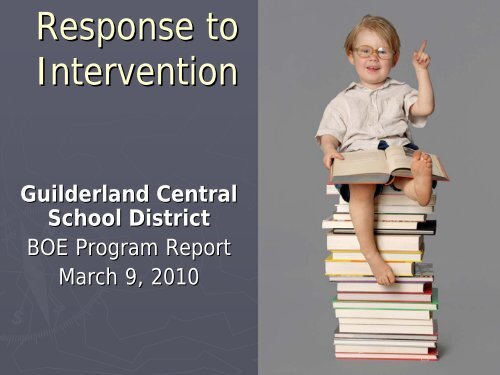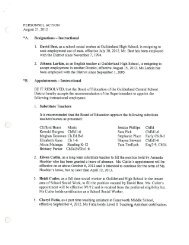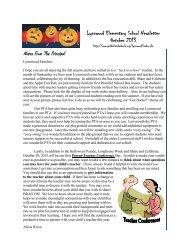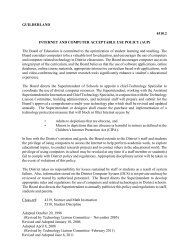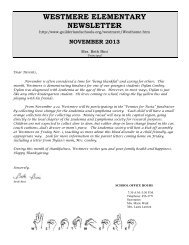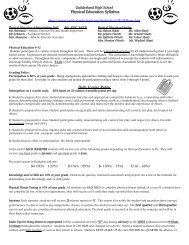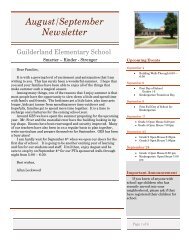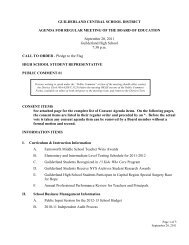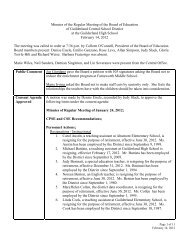Response to Intervention (RTI) - Guilderland Central School District
Response to Intervention (RTI) - Guilderland Central School District
Response to Intervention (RTI) - Guilderland Central School District
Create successful ePaper yourself
Turn your PDF publications into a flip-book with our unique Google optimized e-Paper software.
<strong>Response</strong> <strong>to</strong><br />
<strong>Intervention</strong><br />
<strong>Guilderland</strong> <strong>Central</strong><br />
<strong>School</strong> <strong>District</strong><br />
BOE Program Report<br />
March 9, 2010
Overview<br />
• Definition and Need<br />
• Basis in Federal and State Law<br />
• Core Principles<br />
• Essential Components<br />
• Simplified Process<br />
• Professional Development Issues<br />
2
What’s s All the Buzz About?<br />
<strong>Response</strong> <strong>to</strong> <strong>Intervention</strong> (RtI)<br />
Provides high-quality instruction/intervention<br />
matched <strong>to</strong> student needs and uses frequent<br />
and ongoing moni<strong>to</strong>ring of student progress <strong>to</strong><br />
make important instructional decisions about an<br />
individual student.<br />
3
<strong>RTI</strong> is…<br />
the practice of providing<br />
high-quality<br />
instruction/intervention<br />
matched <strong>to</strong> student needs<br />
and<br />
using learning rate over time<br />
and level of performance<br />
<strong>to</strong><br />
inform educational decisions<br />
4
Why do we need <strong>RTI</strong>?<br />
The discrepancy model fails <strong>to</strong> address the following:<br />
•new legal requirements for documented intervention<br />
attempts within the confines of least restrictive<br />
environment before special education supports can be<br />
considered.<br />
• “rule out” other fac<strong>to</strong>rs<br />
• Curriculum-gaps/lack of instruction<br />
• ESL issues<br />
• Environmental, Cultural, or Economic Fac<strong>to</strong>rs<br />
• Presence of another condition (e.g., emotional disturbance; visual,<br />
hearing, or mo<strong>to</strong>r disability)<br />
•Data-Informed Problem Solving: What works? (i.e., What<br />
type of instruction does the student need <strong>to</strong> increase his/her<br />
rate of progress?)<br />
5
Why do we need <strong>RTI</strong>?<br />
Problems with the traditional system:<br />
►Separation of special ed. and general ed.<br />
►Eligibility Eligibility procedures disconnected from intervention<br />
►Wait-<strong>to</strong>-fail model (reactive)<br />
►Over-representation representation of some minority students<br />
►Overidentification<br />
of students with disabilities<br />
►Failure Failure <strong>to</strong> serve at-risk risk and low achieving students<br />
6
Basis for RtI in Federal Law<br />
• 1975: Initial purpose <strong>to</strong> provide Free<br />
Appropriate Public Education (FAPE) in a<br />
Least Restrictive Environment (LRE)<br />
• 1980s: Shift from access <strong>to</strong> schools <strong>to</strong><br />
access <strong>to</strong> curriculum and instruction, and<br />
<strong>to</strong> results in learning (i.e., inclusion)<br />
• Now: Accountability for learning language<br />
in NCLB and IDEA ’04 are similar<br />
7
From NCLB:<br />
A blurring of the lines……<br />
“…holding schools, local education agencies, and States<br />
accountable for improving the academic achievement of all<br />
students…”<br />
and “…promoting school wide reform and ensuring<br />
the access of all children <strong>to</strong> effective, scientifically-based<br />
instructional strategies…”<br />
[PL 107-110<br />
110 §1001(4) and (9)]<br />
From IDEA:<br />
“…<strong>to</strong> improve the academic achievement and functional<br />
performance of children with disabilities including the use of<br />
scientifically based instructional practices, <strong>to</strong> the maximum<br />
extent possible.”<br />
[20 U.S.C. 1400(c)(5)(E)]<br />
8
NYS Regula<strong>to</strong>ry Amendments<br />
►Part Part 117<br />
►Part Part 100<br />
►Part Part 200<br />
AS PROFESSIONALS…WE MUST<br />
CONSIDER THIS PROCESS FOR ANY<br />
STUDENT DEMONSTRATING ACADEMIC<br />
DEFICITS, NOT ONLY THOSE THAT ARE<br />
SUSPECTED OF HAVING A LEGALLY<br />
DEFINED “DISABILITY”<br />
Effective on July 1, 2012 a school district must have an RtI process in place,<br />
as it may no longer use the severe discrepancy between achievement and<br />
intellectual ability <strong>to</strong> determine that a student in grades K-5 K 5 has a learning<br />
disability in the area of reading.<br />
*Similar legislation anticipated for identification of disabilities ies in mathematics and<br />
behavior.<br />
9
RtI Core Principles<br />
► Teach all children effectively<br />
► Intervene early<br />
► Use a multi-tier tier model of service delivery<br />
► Using assessments for: (1) universal screening; (2)<br />
progress moni<strong>to</strong>ring; and (3) diagnostics<br />
► Adopt a problem-solving methodology based on collected<br />
data measuring student’s “response <strong>to</strong> attempted<br />
interventions”<br />
10
Essential Components of <strong>RTI</strong><br />
Implementation<br />
1. Multi-tier tier model<br />
2. Problem-solving method<br />
3. Integrated data collection/assessment<br />
system<br />
11
Essential Component 1: Multi-tier Model<br />
12<br />
12
Tier 1 Summary: Core<br />
Instructional <strong>Intervention</strong>s<br />
80%<br />
Focus<br />
Setting<br />
Curriculum and<br />
instruction<br />
General education core practices<br />
General education classrooms<br />
Research-based, comprehensive and aligned with state standards/student outcomes; culturally<br />
responsive; positive and safe school climate; responsive <strong>to</strong> individual needs<br />
<strong>Intervention</strong>s<br />
Differentiation of instruction within the general education classroom, e.g., through flexible small<br />
groups and appropriate instructional materials matched <strong>to</strong> students’ needs and abilities<br />
<strong>Intervention</strong>ists<br />
Assessments<br />
General education teachers with consult from school specialists<br />
Universal common assessments of all students (benchmark data) <strong>to</strong> identify students in need of<br />
intervention early; common formative assessments <strong>to</strong> guide and differentiate instruction; data <strong>to</strong><br />
evaluate and moni<strong>to</strong>r the effectiveness of planned intervention, additional assessments of certain<br />
individual students (e.g., checklists, observations, diagnostic assessments) as warranted<br />
Data analysis and<br />
decision making<br />
(Performance Plus)<br />
Support team <strong>to</strong> inform intervention planning and identify individual students in need of Tier II<br />
academic or behavioral intervention, <strong>School</strong> and grade/content area data teams; district data team<br />
analyzes data across schools within a district; district data team analyzes benchmark data within a<br />
school <strong>to</strong> establish the overall efficacy of curriculums, instruction, and moni<strong>to</strong>rs fidelity of<br />
implementation; grade-level/content area data teams analyze common formative assessments <strong>to</strong><br />
improve and differentiate instruction within a grade or course, and identify individual students in need<br />
of Tier II academic or behavioral intervention<br />
13
Tier 2 Summary: Targeted<br />
<strong>Intervention</strong>s<br />
10-15%<br />
Focus<br />
Students failing <strong>to</strong> meet important academic benchmarks or social/behavioral expectations, who have not<br />
responded <strong>to</strong> Tier I core practices<br />
Setting<br />
General education classrooms or other centers for specialized support as determined by support team<br />
<strong>Intervention</strong>s<br />
<strong>Intervention</strong>ists<br />
Assessments<br />
Data analysis and<br />
decision making<br />
(Performance Plus)<br />
Appropriate short-term (e.g., eight <strong>to</strong> 20 weeks) interventions, well-matched <strong>to</strong> students’ specific<br />
academic, social-emotional, and/or behavioral needs; delivered <strong>to</strong> homogeneous groups (i.e, students with<br />
similar needs); with a teacher: student ratio up <strong>to</strong> 1:4 or 1:6; implemented with fidelity; supplemental <strong>to</strong><br />
core program<br />
General education teachers, specialists or other interventionists trained for Tier II intervention<br />
Frequent progress moni<strong>to</strong>ring (e.g., weekly or biweekly) using assessment <strong>to</strong>ols that accurately target<br />
students’ focus area for improvement; progress moni<strong>to</strong>ring <strong>to</strong>ols must be feasible and technically adequate<br />
<strong>to</strong> administer multiple times <strong>to</strong> assess student growth; additional assessments of certain individual students<br />
(e.g., observations, diagnostic assessments)<br />
Teacher support/intervention teams that may overlap with IST; may include core team members (e.g.,<br />
school principal, general educa<strong>to</strong>rs, reading/language arts consultant, school psychologist and a special<br />
educa<strong>to</strong>r) as well as additional members depending on individual student’s needs (e.g. ESL teacher, math<br />
specialist, school social worker); teams match appropriate Tier II interventions <strong>to</strong> students’ needs; select<br />
appropriate progress moni<strong>to</strong>ring <strong>to</strong>ols; analyze progress moni<strong>to</strong>ring data; modify or substitute new<br />
interventions as needed; identify students not responding <strong>to</strong> Tier II efforts; conduct extensive analysis and<br />
application of data from Tier II interventions <strong>to</strong> document effectiveness of interventions; and help moni<strong>to</strong>r<br />
fidelity of implementation of Tier II interventions<br />
14
Tier 3 Summary: Intensive<br />
<strong>Intervention</strong>s<br />
5%<br />
Focus<br />
Students failing <strong>to</strong> meet important academic benchmarks or social/behavioral expectations who have not<br />
responded <strong>to</strong> Tier I or Tier II efforts<br />
Setting<br />
General education classrooms and other centers for specialized and intensive support<br />
<strong>Intervention</strong>s<br />
Appropriate short-term (eight <strong>to</strong> 20 weeks) interventions, well-matched <strong>to</strong> students’ specific academic,<br />
social/behavioral needs; more intensive or individualized than Tier II interventions; delivered <strong>to</strong><br />
individual students or homogeneous groups (i.e., students with similar needs); with a teacher: student<br />
ratio up <strong>to</strong> 1:3; implemented with fidelity; supplemental <strong>to</strong> core program and Tier I efforts<br />
<strong>Intervention</strong>ists<br />
Assessments<br />
Specialists or other interventionists trained for Tier III intervention (may include general educa<strong>to</strong>rs with<br />
appropriate training)<br />
Very frequent progress moni<strong>to</strong>ring (e.g., twice per week) using assessment <strong>to</strong>ols that accurately target<br />
students’ focus areas for improvement; progress moni<strong>to</strong>ring <strong>to</strong>ols must be feasible and technically<br />
adequate <strong>to</strong> administer multiple times <strong>to</strong> assess student growth; additional assessments of certain<br />
individual students (e.g., diagnostic assessments, comprehensive evaluation) as warranted<br />
Data analysis and<br />
decision making<br />
(Performance Plus)<br />
Teacher support/intervention teams (as in Tier II); teams decide how <strong>to</strong> choose, individualize and<br />
intensify interventions for students receiving Tier III interventions; select appropriate progress<br />
moni<strong>to</strong>ring <strong>to</strong>ols; analyze progress moni<strong>to</strong>ring data; modify or substitute new interventions as needed;<br />
identify students not responding <strong>to</strong> Tier III efforts; conduct extensive analysis and application of data<br />
from Tier III interventions <strong>to</strong> document effectiveness of interventions; and help moni<strong>to</strong>r fidelity of<br />
implementation of Tier III interventions<br />
15
Essential Component 2: Problem-Solving<br />
and Decision Making<br />
Define the Problem<br />
(Screening and Diagnostic Assessments)<br />
What is the problem and why is it happening?<br />
Did the<br />
intervention work?<br />
Analysis of all<br />
collected data<br />
What are we going<br />
<strong>to</strong> do?<br />
Define and Identify<br />
<strong>Intervention</strong> and Progress<br />
Moni<strong>to</strong>ring<br />
Implement Plan<br />
(Treatment Integrity)<br />
Carry out the intervention<br />
16
Essential Component 3: Integrated data<br />
collection/assessment system<br />
► RtI Advisory Council Subgroup: Researched and adopted<br />
Performance Plus<br />
• Assessment data management solution for tracking and<br />
moni<strong>to</strong>ring student achievement and “response <strong>to</strong><br />
interventions”<br />
• Aligns district performance results <strong>to</strong> NYS Learning<br />
Standards<br />
• Provides complete longitudinal profiles and analyses of<br />
student achievement<br />
• Includes Assessment Builder for efficient development,<br />
scoring and analysis of state and local benchmark<br />
assessments<br />
• Immediate review of student response <strong>to</strong> intervention<br />
supports data-informed informed instruction and problem solving<br />
efforts.<br />
17
Professional Development Needs<br />
Critical Areas:<br />
►Collaboration between general and special<br />
educa<strong>to</strong>rs<br />
►Changing roles and responsibilities<br />
►<strong>School</strong> leadership<br />
►Data gathering and data analysis<br />
►Identifying appropriate research-based<br />
instruction/interventions<br />
18
Professional Development Needs<br />
Critical Areas:<br />
►Awareness training with teachers<br />
administra<strong>to</strong>rs<br />
• Must include all of the core components of <strong>RTI</strong><br />
• Deeper training with implementers<br />
• Ideally job integrated<br />
• Coaching and support<br />
►Training is typically ongoing because<br />
• <strong>RTI</strong> has many moving parts<br />
• <strong>RTI</strong> is ever evolving - new information is continually<br />
becoming available.<br />
19
RtI Advisory Council<br />
First Name Last Name Building<br />
Leslie Abel GES<br />
Bill Aube FMS<br />
Matt Ball FMS<br />
Nancy Brumer DO<br />
Mary Helen Collen DO<br />
Nancy DeStefano FMS/GHS<br />
Meghan DiMartino WES/PBES<br />
Kirsten Eidle-Barkman GES<br />
Mike Ellerbrock FMS<br />
Tammi Furlong LES<br />
Steve Hadden DW<br />
Heather Hanrahan FMS<br />
Tricia Hansbury-Zuendt GHS<br />
Reva Kinnally WES<br />
Mark Kotary GHS<br />
Kim Letky GHS<br />
Allan Lockwood GES<br />
Lisa McClure FMS<br />
First Name Last Name Building<br />
Lisa Nissenbaum GHS<br />
Shauna Otsu-Schechner LES<br />
Lisa Patierne GHS<br />
Merri Peer WES<br />
Brian Quigg GHS<br />
Michelle Rispole AES<br />
Kathie Robertson FMS<br />
Chris Sanita PBES<br />
Liza Schofield LES/PBES<br />
Brit<strong>to</strong>n Schnurr LES<br />
Demian Single<strong>to</strong>n DO<br />
Kathy Smigen WES<br />
Meg Urbanski PBES<br />
Keith VanWagenen PBES<br />
Vanessa Volpe LES<br />
Mary Ursillo PBES<br />
Lynne Wells FMS<br />
20
Reflections!<br />
<br />
Questions?<br />
Discussion.<br />
?<br />
21


